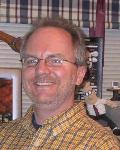|
 Dave Gingerich became an employee of Lockheed
Martin in December 1980 after finishing his M.S.
in Mechanical Engineering at Colorado State University
and for the next seven years he developed simulation
software used to test the power and attitude control
subsystems for two large, earth-orbiting spacecraft.
Dave Gingerich became an employee of Lockheed
Martin in December 1980 after finishing his M.S.
in Mechanical Engineering at Colorado State University
and for the next seven years he developed simulation
software used to test the power and attitude control
subsystems for two large, earth-orbiting spacecraft.
In 1987, he made a switch to developing spacecraft
bus and instrument flight software for numerous
planetary exploration missions and payloads. For
example, Dave was a member of the small team that
developed the instrument flight software for the
Descent Imager and Spectral Radiometer on the
Cassini-Huygens Probe and prior to that assignment
he was the flight software lead engineer for the
Mars Observer Gamma Ray Spectrometer. In the early
1990s he was a member of the flight software development
team for the marvelously successful and still
flying Mars Global Surveyor.
One of the toughest assignments Dave has had during
his career was a robot development effort in 1996
that created a small, autonomous vehicle about
the size of an office desk capable of navigating
rows of 55-gallon drums of radioactive waste stacked
4-high while scanning their sides for early indications
of a potential leak. This culminated in an extended,
on-site demonstration at a former nuclear weapons
production facility in Ohio where the team worked
for seven weeks in June and July without air-conditioning
inside a low-level, waste storage facility that
closely resembled a circus tent longer than a
football field. During a thunderstorm, rain and
hail on the taut skin of the tent made working
there like working inside of a snare drum and
all conversation among the engineering crew had
to cease until the storm abated.
In 1997, Dave moved on and spent the next four
years developing the payload and science flight
software for the Stardust and Genesis missions.
Due to his "inception to integration"
success with the payload software on these two
sample return missions, Dave was asked to join
the LMA Mission Operations team and continue his
involvement with the Genesis and Stardust science
and payload subsystems until each mission returns
to the Utah desert. In 2002 he implemented a change
to the Stardust Navigation Camera flight software
that was successfully demonstrated during Stardust's
encounter with asteroid Annefrank in November
and for which he was presented a Technical Excellence
award from Lockheed Martin at Honors Night in
April 2003. He is also the recipient of several
NASA Group Achievement awards.
Dave earned a B.S. in Mathematics in 1979 from
Whitman College in Walla Walla, Washington and
will complete his second Masters degree next spring
in Space Operations Management from Webster University.
He grew up in Western Oregon and although he enjoys
mountain biking, hiking and skiing in the Colorado
Rocky Mountains, he still misses the beautiful
Oregon coastline after living in Colorado for
24 years.
| Last updated
November 26, 2003 |
|
